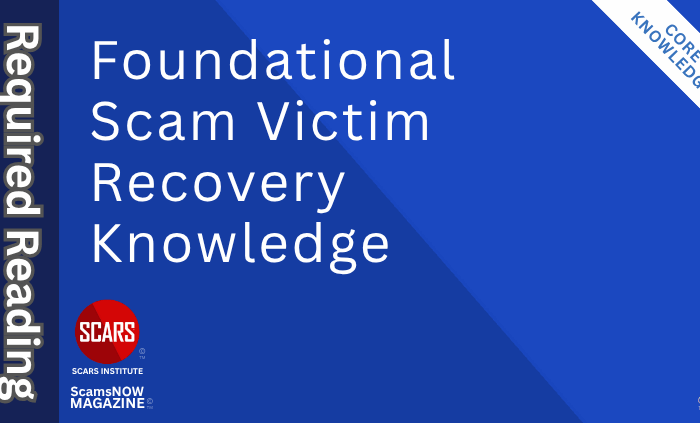
An Alternate Path to Recovery for Single Scam Victims
Mutual Recovery as a Couple After Trauma: A Research and Practice Brief
The Garapata Theory of Scam Victim Recovery
Primary Category: Scam Victim Recovery Psychology
Authors:
• Vianey Gonzalez B.Sc(Psych) – Licensed Psychologist, Specialty in Crime Victim Trauma Therapy, Neuropsychologist, Certified Deception Professional, Psychology Advisory Panel & Director of the Society of Citizens Against Relationship Scams Inc.
• Tim McGuinness, Ph.D., DFin, MCPO, MAnth – Anthropologist, Scientist, Polymath, Director of the Society of Citizens Against Relationship Scams Inc.
Author Biographies Below
About This Article
When two trauma survivors, such as those recovering from romance scams, form a relationship, it can potentially support mutual healing, though deliberate partner-seeking during recovery is risky and often leads to further harm. Organic, in-person connections with someone who understands trauma may foster recovery through shared empathy, but success hinges on clear boundaries, slow pacing, and mutual respect for triggers. Practices like co-regulation, transparent communication, and separate finances, alongside external support like therapy, can stabilize both partners. However, pitfalls like trauma bonding, co-rumination, or attracting harmful individuals are common, especially with online searches, which amplify distrust and exposure to scammers. The article advises against pursuing relationships as a recovery strategy, emphasizing patience and self-focused healing. When relationships arise naturally, careful evaluation, consent, and body-aware habits like calm routines can nurture a safe, healing bond, provided both partners prioritize accountability and avoid dependency.
Note: This article is intended for informational purposes and does not replace professional medical advice. If you are experiencing distress, please consult a qualified mental health professional.

Mutual Recovery as a Couple After Trauma: A Research and Practice Brief
Dedicated to those who broke this ground and established the template: Debra, Debby, and others.
Author’s Note:
This is an introduction to what might happen when two traumatized people meet and explore a relationship.
This article is based on real experience working with survivors who have successfully taken this route. We have seen examples of how this can succeed, but also more examples of how it failed. This is not something you plan for, because planning, by definition, creates expectations that can lead to unrealistic projections when someone comes along. On the other hand, if something happens naturally, organically, and locally, then it may be worth exploring. Just be careful. Remember that your trauma and that of the other person may mislead you into new danger.
Survivors
People who become victimized in romance scams were vulnerable because they were looking for a partner and wandered in front of a predator on a dating website, social media, etc. Most were actively looking for a partner, though some chanced into it by simply encountering someone to talk to who paid attention to them.
What is often curious is the extent of the savior aspects of these relationships. Men try to be a ‘White Knight’ and save the women they encounter, and women have their maternal instincts triggered by the distress that the ‘person’ is in. In both cases, often these scam relationships are built on the idea that the victims are playing the role of savior, usually without realizing it.
Then comes the scam and the ultimate realization of the scam, and then the betrayal trauma that results. We have already documented several times what this trauma does to victims and what the normal pathways to recovery are like, but there is an alternative pathway from the Yellow Brick Road that we have never explored before.
Recovery through Relationship
Please note: this is not something that can be recommended for scam survivors, but it does happen. We do not recommend that anyone going through recovery after a serious trauma ever consider looking for a relationship with another person. The dynamics of recovery and the emotional instability of the survivor are serious opportunities for danger of many kinds, including deepening their trauma or choosing the wrong kind of person. Domestic abuse victims often fall into new abusive relationships. This danger is very real and almost always a bad idea.
However, having said that, there are chance situations that come up in life. One such is meeting someone who may understand your trauma because they themself have suffered a serious emotional trauma in the past and have their own demons they are exorcising. This has happened to survivors in our care, and we have been surprised by how well it has worked. But we have also observed that those who sought out a relationship purposefully usually failed and were left more damaged than before.
- First, never start out by looking for another person during your recovery; this will fail very badly and lead you to the wrong kinds of people or profound disappointment that can tip you into depression or other disorders.
- Second, never look for someone online. You will only confirm and dig deeper into your feelings of distrust as you encounter more scammers or people who are unsuitable. Simply do not go there.
Entering a new relationship during recovery from serious trauma can carry real risk. Early months often include emotional instability, heightened vulnerability, and strained judgment, which can open the door to further harm. Domestic abuse survivors, for example, often encounter new abusive partners. Seeking a partner as a recovery strategy is not recommended.
Life can still bring chance meetings. On rare occasions, someone met in an ordinary setting may understand trauma because they have also endured a serious emotional injury and are doing their own healing work. In those moments, care, clarity, and pace matter more than interest or chemistry.
Beginning a deliberate search for a partner while recovering tends to end poorly. Intense needs, grief, and loneliness can attract the wrong people, lead to disappointment, and deepen symptoms such as anxiety or depression. Online outreach adds additional risk. Scammers, misrepresentation, and chaotic dynamics are common, so avoiding online pursuit during recovery can protect trust, safety, and stability.
If a natural, in-person connection appears, a slow, transparent approach may reduce risk. Early conversations can include brief, honest context without full disclosure. A boundary statement sets the frame and protects pace. One example is, “I have just been through a traumatic experience, and I am not looking for a relationship right now.” A low-stakes step, such as coffee in a public place, allows time to observe respect, consistency, and listening skills. Openness about current limits, separate finances, and no-pressure contact can serve as early safeguards.
Recovery requires patience, clear boundaries, and steady routines. If a relationship possibility appears by chance, treating it as a gradual evaluation, rather than a solution, can protect health, preserve dignity, and keep healing on track. However, note that a relationship can also be a terrible idea since it can stop recovery and lead someone off the recovery path (the Yellow Brick Road.)
What is the Idea?
The question is: can a structured couple-based approach improve symptoms, develop a quality relationship, and function for two adults with significant trauma histories?
Many survivors ask whether two people with serious trauma histories can build a steady, loving partnership that supports healing. This outlines what may help, what may harm, and how a study or program could evaluate the idea. As you consider this path, the goal is mutual support, not dependency, with attention to safety, pacing, and consent.
Mutual recovery in couplehood means two traumatized partners choose a relationship where compassion, stable routines, and clear agreements help each person regain their health. The emphasis rests on acceptance of each other’s vulnerabilities, shared language for their symptoms, and real skills that calm the body and clarify the needs of each person. This model differs from trauma bonding, which depends on coercion or control.
Two survivors may bring unusual empathy, patience, and humility into such a relationship – the SCARS Institute has seen this work firsthand, but we have also seen it fail. Each partner has to recognize triggers, respect each other’s limits, and offer real co-regulation, such as calm breathing, a brief walk, or quieter evenings, whatever the other person needs, without judgment or impatience. When partners strengthen their daily rhythms together, the stress system of each person often settles, sleep improves, and decisions slow to a safer pace.
However, unresolved symptoms can align in ways that raise risk. Co-rumination may increase anxiety. Recovery avoidance can become a reality that blocks ongoing care. Old patterns, such as people-pleasing or harsh self-talk, may move between partners. Without boundaries, mutual support can tilt toward over-functioning, resentment, or burnout. Trauma bonding can be mistaken for love if control, secrecy, or fear drives closeness. Especially dangerous is one person continuing their recovery and the other person stopping.
The picture is more favorable when both partners can:
- Talk openly about their vulnerabilities, their fears, anxieties, and challenges as they happen without judgment
- Name emotions with simple words, and accept short pauses;
- Keep basic routines, including sleep, meals, and light daily movement;
- Tolerate short discussions of hard events without attack or retreat;
- Welcome outside support from a therapist, physician, or peer group;
- Repair strain with timely apologies, specific requests, and follow-through.
Relationship practices that may help
- Shared language. Agree on two or three phrases that mark triggers and needs.
- Body-first habits. Morning light, regular meals, post-stress walks, and an evening wind-down.
- Boundaries and consent. Opt-in for hard topics, options to pause, and no forced disclosure.
- Crisis plan. If panic, rage, or dissociation rise, each partner has a preunderstood plan, including who to call, how to reduce stimulation, and when to seek medical care.
- Growth channels. Each partner pursues at least one individual support, such as therapy or a skills group, so the relationship is not the only container.
Benefits Of A Healthy Pairing After Trauma
A good pairing with another traumatized person can offer steady understanding that is rare elsewhere. Shared experience means fewer explanations, less doubt, and more space to breathe. When someone already knows how betrayal scrambles sleep, appetite, and attention, your daily signals make sense. That recognition eases shame, lowers defensiveness, and allows honest talk about fear, grief, and anger without apology.
Mutual pacing becomes possible. Two people who respect slow steps can agree on clear check-ins, calm pauses, and time limits that keep bodies settled. Your nervous systems can learn from each other through co-regulation. Quiet time, short walks, and soft voices become routine, and your heart rate often follows. When both of you practice the same small skills, such as longer exhales or short statements that set limits, progress tends to hold.
Communication can grow clearer. Words like “trigger,” “freeze,” and “spiral” already have meaning, so conversations move faster to what helps. You can describe facts, feelings, and next steps in simple language and be heard. That clarity reduces arguments rooted in misunderstanding, and turns hard talks into planned moments with purpose. When either of you slips into shame or rumination, the other can notice, name it kindly, and invite a short reset.
Boundaries often strengthen in a healthy pair. Respect for privacy, consent, and money rules becomes a shared value rather than a source of friction. You can keep separate finances, agree on no-money requests, and support verification before commitments. These habits lower risk, protect dignity, and teach both of you that safety and closeness can live together.
Accountability can feel safer. A partner who understands trauma can offer gentle feedback without blaming. Short reflections like “that sounded like panic speaking” or “let’s slow this choice” may help you spot patterns before they harm the day. With agreed guardrails, accountability turns into teamwork rather than control, and small course corrections happen early.
Recovery skills often multiply when practiced together. Sleep routines, morning light, regular meals, and brief post-stress walks are easier to keep when both of you care about them. Shared calendars, reminders, and check-ins can raise follow-through without pressure. Over time, your bodies learn a steadier rhythm, cravings quiet, and decisions improve.
Healthy conflict becomes a teacher. Two people who value repair of trust can learn to argue with respect, return to the point, and stop when voices rise. Clear statements, short breaks, and simple apologies restore contact without reopening old wounds. Each resolved conflict builds confidence that the bond can hold.
Meaning can return through service and small joys. A balanced pair may volunteer, attend support groups, or help others learn early warning signs. Purpose grows when pain is used to protect, teach, or guide. Quiet pleasures also matter. Shared cooking, short nature time, music, and simple routines remind your bodies that life still offers comfort and connection.
Intimacy can become safer and more honest. Gentle pacing, accurate language, and clear consent help both of you feel respected. When emotions rise, you can pause together, breathe, and decide what feels right for the moment. Trust grows when touch, words, and timing match.
Resilience often expands in a healthy pair. Hard days still come, yet they arrive to a team that knows how to steady, sort, and choose. With practice, you carry each other through spikes without losing direction. The relationship then serves as a shelter where truth is welcome, limits are honored, and hope has daily proof.
How to Say Hello and Begin a Conversation
NOTE: Like it or not, in today’s hyper-feminist world, men are not going to reach out first, generally speaking. It is up to the woman to make the first move. You can do that by saying hello or offering a seat at your table. Just a small gesture is enough to start a conversation and lower the barriers.
A simple greeting opens the door without strain. A calm “Hello,” followed by “It’s nice to meet you,” sets a steady tone and shows respect. A brief context statement can set a gentle pace without oversharing: “I am taking things slowly after a difficult experience.” Clear words like these protect emotional space and keep expectations balanced.
Shared surroundings offer a safe ground to meet someone, and different places invite different openers. In a café, a low-pressure start may sound like “This place feels calm today. How is your afternoon going?” In a park, a natural opening may be “The air feels clear after the rain. Do you come here often?” In a bookstore, try “That section has good picks. Did anything catch your eye?” In a community class, a gentle approach may be “The group seems welcoming. What brought you in today?” After a talk or support meeting, a present-focused question can be “The speaker made a clear point about community. What stood out for you?” Concrete details keep attention in the present, which lowers anxiety and makes trust easier to assess.
Early boundaries help the pace stay safe. A short sentence can mark limits and still welcome conversation: “I am moving carefully these days, so I’m keeping things simple.” If questions turn toward private history, a courteous redirect preserves dignity: “I am not ready for the details, yet I’m glad to talk about your work or interests.” Clear limits, stated kindly, tend to invite better respect.
Small disclosures work best when paced. One sentence about interests, routine, or values offers a picture without opening old wounds. For example, “My weekends are for a quiet walk, a good book, and time with my family.” The other person’s response provides useful signals. Gentle listening, a matched pace, and questions that stay on topic point to care. Quick pressure, prying for details, or jokes about boundaries can signal risk. A tightened jaw, a knot in the stomach, or a fast pulse may suggest it is time to pause.
Clear closings reduce mixed signals. If the exchange feels steady, a low-pressure next step may help: “I enjoyed talking. Would a short coffee next week make sense?” If the fit feels off, a kind wrap-up keeps the moment clean: “It was good to meet you. Wishing you a good evening.” Contact details, if shared, can stay focused by agreeing on a narrow first message, such as confirming a time and place.
Bridge to a short exchange
-
- Offer a brief, true detail to invite response: “I came today to learn and meet a few people.”
- Follow with one easy, open question: “What brought you here today?”
- Reflect something you heard, then pause: “That makes sense. It sounds important to you.”
Name the pace and comfort level
-
- Setting a light boundary builds trust: “I like short chats at first, then coffee if it feels right.”
- If sharing a limit, keep it simple: “I’m taking things slowly at the moment.”
- If the other person leans in, a kind check helps: “Is this a good time to keep talking?”
Invite a next step, without pressure
-
- Offer a low-stakes option: “I’m grabbing coffee after this. Would you like to join for ten minutes?”
- Suggest a clear follow-up: “If you want to continue, we could meet here next week.”
- Keep consent visible: “No worries if not. It was good to meet you.”
Close with care
-
- End well, even if there is no next step: “Thanks for the chat. I enjoyed talking with you.”
- If interest is mutual, confirm one detail: “Let’s exchange first names and meet at the front entrance after the session.”
Gentle safety notes
-
- Public, well-lit places, short time frames, and clear exits help new conversations feel steady.
- Honest, light disclosures, not full histories, protect privacy while building rapport.
- Curiosity, clear sentences, and pauses signal respect, reduce anxiety, and leave room for a real connection to grow.
Go and No-Go Signals
Here are some ‘clear’ early “go” and “no-go” signals when meeting someone new after trauma. The aim is a steady pace, honest contact, and respect for limits, so safety grows rather than shrinks.
Go Signals
-
- Consistent respect for your boundaries. When a limit is stated, it is accepted without pressure, debate, or guilt-trips.
- Realistic pacing. Messages and plans match your comfort level, with no rush for labels, intimacy, or money.
- Transparent identity. Basic facts are shared, and verification is welcomed. Social media, work, and your general background align.
- Accountability for harm. If a mistake happens, and a specific apology appears, it must be followed by a small corrective action.
- Stable routines. Communication shows up on a predictable schedule, and long gaps are explained calmly.
- Curiosity without digging. Interest in your story is present, yet private details are not pressed for. Both people need to let this flow naturally, organically, over time.
- Parallel supports. Personal therapy, peer support, or healthy practices are described without shame.
- Calm conflict skills. Disagreement stays respectful, with time-outs, short pauses, and a return to the point.
- Financial clarity. No requests for loans, gifts, crypto, or shared accounts. Expenses are handled separately – meaning each pays for their own.
- Body-first awareness. Breaks for food, water, sleep, and movement are treated as normal.
No-Go Signals
-
- Speed and intensity. Any characterization of feelings early.
- Boundary testing. “Just this once,” repeated requests after a no, or anger when a limit is stated.
- Secrecy and isolation. If they do not want to be seen in public is a bad sign.
- Money talks. Any discussions about money are a bad sign. Even about money, you may have lost because it invites comparisons.
- Identity gaps. Inconsistent stories, blurred timelines, missing verifications, or evasive answers to simple questions.
- Blame and scorekeeping. Past harms they use to excuse current behavior, or shifting fault onto you when concerns are raised.
- Coercion in communication. Rapid-fire texts, late-night demands, or punishment by silence when a reply is delayed.
- Substance or rage spikes. Repeated intoxication, explosive anger, threats, or property damage – walk away.
- Disrespect for care. Mocking therapy, sleep, medication, or other health routines – walk away.
- Triangulation. Attempts to make you jealous, provoke competition, or pit you against others – walk away.
Simple Field Tests
-
- The boundary test. Share one small limit, then wait. A “go” response accepts the limit and adjusts. A “no-go” response argues, sulks, or retaliates.
- The verification test. Suggest a brief video call or a public meet with a friend nearby. A “go” response agrees or offers a reasonable alternative. A “no-go” response dodges, delays, or shames.
- The time test. Ask for a slower pace. A “go” response keeps steady contact. A “no-go” response pushes harder or disappears, then returns with pressure.
- The money test. Mention a firm no-money rule. A “go” response respects it. A “no-go” response probes or proposes a “safe” workaround.
If You are Uncertain
-
- Name what feels off, in one calm sentence, and take a day to observe.
- Share a brief summary with a trusted person, and ask for their view.
- Keep personal details, photos, locations, and finances private until trust is earned over time.
Trust grows when words, actions, and timing match. Pressure, secrecy, and money requests are early exits. Patience, clarity, and steady boundaries protect your health, while a real connection, if it exists, has room to form.
Conclusion
There may come a point where you begin to think about seeking another person; you may want connection, relief, and a sense that life can make sense again.
However, looking for a new relationship is almost always a bad idea. If one happens organically, with someone local, then that is a different opportunity.
Recovery after betrayal asks for patience, clear limits, and steady routines that respect your pace. A new relationship can appear by chance while this healing unfolds, and real care needs to be taken to not make things worse. Going in this with open eyes and careful steps can protect both your health and your dignity. Seeking a partner as a strategy often backfires, since early recovery brings strong feelings, narrowed judgment, and higher risk. Treating any new interest as an evaluation, not a solution, offers a safer path.
A steady foundation begins with plain, truthful language, honest context, and boundaries that hold. Short, respectful statements set expectations, reduce pressure, and keep choices aligned with values. Separate finances, public settings, and calm pacing protect trust while it grows. Attention to body signals matters as well. A tight jaw, a knot in the stomach, or a racing heart may signal a need to pause and reset.
Mutual support can help when it is grounded in consent, clarity, and rhythm. Two people can learn each other’s cues, share brief practices that calm the nervous system, and talk about triggers without blame. Outside support remains important. A therapist, a physician, or a support group can add skills, monitor risk, and steady the plan.
There is room for hope here, but it also requires caution. With time, truthful words, and small, repeatable habits, your days can hold both feeling and focus. The aim is not perfection. The aim is a life that honors your limits, invites safe connection, and lets meaning return at a pace that fits your life living with trauma.

Glossary
- Acceptance — A person allows the reality of what happened without excusing harm. Acceptance can lower resistance, steady breathing, and create room for grief and planning. It does not mean approval; it means the fight with the facts eases so healing can begin.
- Accountability — A person recognizes the effects of actions, offers a specific apology, and takes a small corrective step. Accountability restores some trust because words and actions match. In mutual recovery, both partners practice this to keep the bond clear.
- Attachment — Emotional bonds track safety, closeness, and loss. After trauma, attachment may feel push-pull, with urges to seek contact and to avoid it. Naming the signals helps pace connection with care.
- Body-First Habits — Calming the nervous system comes before problem-solving. Light movement, longer exhales, regular meals, and a simple evening wind-down may lower reactivity and improve sleep. A calmer body makes clearer thinking possible.
- Boundary Statement — A kind, clear limit protects pace and safety. Examples include, “I am taking things slowly,” or, “No money requests.” Short limits reduce pressure and teach others how to respond.
- Boundaries — Markers define what is safe for time, body, attention, and money. Strong boundaries reduce risk, clarify expectations, and support dignity. In a new connection, boundaries guide the speed and shape of contact.
- Co-Regulation — Two people share steady cues that calm breathing, posture, and voice. Quiet presence, soft tone, and short walks can lower arousal for both. This skill turns care into a practical tool.
- Co-Rumination — Two people replay painful events together without moving toward facts or action. The talk may feel close yet increase anxiety and fatigue. Noticing this pattern allows a shift toward brief, focused support.
- Consent — Choice governs contact, pace, and topics, free of pressure. Consent includes the option to pause or stop at any point. Keeping consent visible builds trust and reduces fear.
- Corrective Action — An apology is followed by one small, concrete step that repairs strain. Returning a call, changing a plan, or adding a reminder shows respect for impact. Action gives the apology weight.
- Crisis Plan — A brief, shared response covers spikes in panic, rage, or numbness. The plan names who to call, where to meet, and how to reduce stimulation. Planning in calm times protects during hard minutes.
- Disclosure (Light) — One or two simple facts introduce a person without opening old wounds. A sentence about routine or values gives a real picture at a safe depth. Light disclosure helps assess fit without risk.
- Evidence Check — Three brief questions separate signal from noise: “What do I know?” “What do I think?” “What do I fear?” This structure lowers confusion and supports steadier choices.
- Financial Clarity — Money stays separate, and loans, gifts, shared accounts, and crypto transfers are declined. Clear rules protect trust while it grows. Clarity also reduces chances for misunderstanding or harm.
- Go Signals — Early behaviors point to safety: steady pacing, respect for limits, openness to verification, and no money talk. Calm listening and matched tone also suggest care. These signs support a second conversation.
- Grounding — Attention returns to the present with simple sensory steps. Feeling the feet, relaxing the jaw, and naming three neutral objects can lower alarm. Grounding creates room for choice.
- Identity Verification — Small, reasonable checks help confirm who someone is. A brief video call, a public meet, or a consistent work history can assist. Openness to verification supports trust.
- Intention and Attention — One focus is chosen on purpose and held briefly. Washing a cup slowly or taking three long exhales can reset looping thoughts. This practice builds steadiness over time.
- Light Rituals — Small, repeatable steps signal safety. Morning light, water, and one sentence in a notebook or journal can set a calm tone. Rituals reduce decision load and teach a predictable rhythm.
- Limits — Clear definitions state what is not available right now, such as long calls, late nights, or personal history. Limits protect energy and prevent overload. Clarity also reduces mixed signals.
- Mutual Recovery — Two partners support healing with consent, routines, and honest words. The aim is steadiness, not rescue. Each person keeps individual supports so the relationship does not carry the whole load.
- No-Go Signals — Early risks include speed, secrecy, boundary testing, identity gaps, and money talk. Pressure, prying, or jokes about limits add concern. These signs suggest a pause or exit.
- Pacing — Speed matches what the body can handle. Short talks, public spaces, and planned breaks keep arousal lower and thinking clearer. Pacing protects both connection and health.
- Present-Focused Language — Concrete, current words replace sweeping claims. Examples include, “A transfer happened on Monday,” or, “I feel tense now.” Specific wording reduces shame and supports problem-solving.
- Reflective Self-Awareness — Thoughts, feelings, and body cues are noticed without self-attack. Description replaces judgment, which lowers alarm and invites care. This stance supports safer choices.
- Repair (Relational) — Strain is addressed with a brief account of impact, a specific apology, and a small change. Repair keeps trust from fraying. Regular practice makes conflicts shorter and less painful.
- Routine — Simple daily anchors repeat, such as meals, light movement, and wind-down. Routine lowers unpredictability, which reduces stress. Shared routines can help partners co-regulate.
- Rumination — Events replay without resolution while the mind searches for a perfect answer that never arrives. Rumination drains energy and narrows attention. Naming it allows a pause and a shift to sorting by time, topic, and evidence.
- Safety Cue — Signals lower threat, such as soft voice, slower pace, or visible exits. Consistent cues help the nervous system settle. Calm follows when signals align with behavior.
- Separate Finances — Money matters remain independent in early connection. Each person pays their own way and declines transfers. This practice reduces risk while character is assessed.
- Shame-Voice — Harsh labels appear, such as “I am stupid,” or “I always fail.” Replacing labels with description—“I was deceived by a criminal”—reduces pain and supports recovery. Kind wording strengthens self-respect.
- Simple Field Tests — Small checks reveal pattern: a boundary test, a time test, a verification test, and a money test. Safe partners accept limits, keep pace, and avoid pressure. These tests protect without drama.
- Transparent Identity — Basic, consistent facts about work, schedule, and general background are shared. Willingness to check details shows good faith. Transparency supports early trust.
- Trigger — A cue brings back the scam or other trauma. Body signs may include a tight jaw, a knot in the stomach, or a racing heart. Naming the trigger allows grounding and a slower pace.
- Trust-Building — Words, actions, and timing match over time. Small promises kept, calm follow-up, and honest context create safety. Trust grows in steps, not leaps.
- Word Choice (Kind, Concrete) — Clear, respectful sentences replace global claims. Phrases like “Let’s pause,” “I need a break,” or “I will call tomorrow at 3,” reduce confusion and protect energy. Kind wording makes hard talks possible.
Reference
- Monson, C. M., & Fredman, S. J. Cognitive-Behavioral Conjoint Therapy for PTSD (Guilford Press): https://www.guilford.com/books/Cognitive-Behavioral-Conjoint-Therapy-for-PTSD/Monson-Fredman/9781462528646
- Johnson, S. M. The Practice of Emotionally Focused Couple Therapy: Creating Connection (ICEEFT book page with publisher links): https://iceeft.com/eft-books/
- Bodenmann, G. Dyadic coping and its significance for marital functioning (chapter overview via APA journal editorial citing Bodenmann’s model): https://www.ncbi.nlm.nih.gov/pmc/articles/PMC2908315/
- Porges, S. W. The Polyvagal Theory: Neurophysiological Foundations of Emotions, Attachment, Communication, and Self-Regulation (Norton—authoritative overview article on NCBI/PMC): https://www.ncbi.nlm.nih.gov/pmc/articles/PMC3108032/
- Feldman, R. Parent–infant synchrony and the construction of shared timing; co-regulation relevant to adult bonds (PubMed author profile with synchrony publications): https://pubmed.ncbi.nlm.nih.gov/?term=Ruth+Feldman+parent-infant+synchrony
- American Psychological Association. Clinical Practice Guideline for the Treatment of PTSD (APA): https://www.apa.org/ptsd-guideline/treatment
- National Institute of Mental Health. Post-Traumatic Stress Disorder (PTSD) overview and treatment evidence (NIMH): https://www.nimh.nih.gov/health/topics/post-traumatic-stress-disorder-ptsd
Author Biographies
-/ 30 /-
What do you think about this?
Please share your thoughts in a comment below!
One Comment
Leave A Comment
Important Information for New Scam Victims
- Please visit www.ScamVictimsSupport.org – a SCARS Website for New Scam Victims & Sextortion Victims.
- SCARS Institute now offers its free, safe, and private Scam Survivor’s Support Community at www.SCARScommunity.org – this is not on a social media platform, it is our own safe & secure platform created by the SCARS Institute especially for scam victims & survivors.
- SCARS Institute now offers a free recovery learning program at www.SCARSeducation.org.
- Please visit www.ScamPsychology.org – to more fully understand the psychological concepts involved in scams and scam victim recovery.
If you are looking for local trauma counselors, please visit counseling.AgainstScams.org
If you need to speak with someone now, you can dial 988 or find phone numbers for crisis hotlines all around the world here: www.opencounseling.com/suicide-hotlines
Statement About Victim Blaming
Some of our articles discuss various aspects of victims. This is both about better understanding victims (the science of victimology) and their behaviors and psychology. This helps us to educate victims/survivors about why these crimes happened and not to blame themselves, better develop recovery programs, and help victims avoid scams in the future. At times, this may sound like blaming the victim, but it does not blame scam victims; we are simply explaining the hows and whys of the experience victims have.
These articles, about the Psychology of Scams or Victim Psychology – meaning that all humans have psychological or cognitive characteristics in common that can either be exploited or work against us – help us all to understand the unique challenges victims face before, during, and after scams, fraud, or cybercrimes. These sometimes talk about some of the vulnerabilities the scammers exploit. Victims rarely have control of them or are even aware of them, until something like a scam happens, and then they can learn how their mind works and how to overcome these mechanisms.
Articles like these help victims and others understand these processes and how to help prevent them from being exploited again or to help them recover more easily by understanding their post-scam behaviors. Learn more about the Psychology of Scams at www.ScamPsychology.org
SCARS INSTITUTE RESOURCES:
If You Have Been Victimized By A Scam Or Cybercrime
♦ If you are a victim of scams, go to www.ScamVictimsSupport.org for real knowledge and help
♦ SCARS Institute now offers its free, safe, and private Scam Survivor’s Support Community at www.SCARScommunity.org/register – this is not on a social media platform, it is our own safe & secure platform created by the SCARS Institute especially for scam victims & survivors.
♦ Enroll in SCARS Scam Survivor’s School now at www.SCARSeducation.org
♦ To report criminals, visit https://reporting.AgainstScams.org – we will NEVER give your data to money recovery companies like some do!
♦ Follow us and find our podcasts, webinars, and helpful videos on YouTube: https://www.youtube.com/@RomancescamsNowcom
♦ Learn about the Psychology of Scams at www.ScamPsychology.org
♦ Dig deeper into the reality of scams, fraud, and cybercrime at www.ScamsNOW.com and www.RomanceScamsNOW.com
♦ Scam Survivor’s Stories: www.ScamSurvivorStories.org
♦ For Scam Victim Advocates visit www.ScamVictimsAdvocates.org
♦ See more scammer photos on www.ScammerPhotos.com
You can also find the SCARS Institute’s knowledge and information on Facebook, Instagram, X, LinkedIn, and TruthSocial
Psychology Disclaimer:
All articles about psychology and the human brain on this website are for information & education only
The information provided in this and other SCARS articles are intended for educational and self-help purposes only and should not be construed as a substitute for professional therapy or counseling.
Note about Mindfulness: Mindfulness practices have the potential to create psychological distress for some individuals. Please consult a mental health professional or experienced meditation instructor for guidance should you encounter difficulties.
While any self-help techniques outlined herein may be beneficial for scam victims seeking to recover from their experience and move towards recovery, it is important to consult with a qualified mental health professional before initiating any course of action. Each individual’s experience and needs are unique, and what works for one person may not be suitable for another.
Additionally, any approach may not be appropriate for individuals with certain pre-existing mental health conditions or trauma histories. It is advisable to seek guidance from a licensed therapist or counselor who can provide personalized support, guidance, and treatment tailored to your specific needs.
If you are experiencing significant distress or emotional difficulties related to a scam or other traumatic event, please consult your doctor or mental health provider for appropriate care and support.
Also read our SCARS Institute Statement about Professional Care for Scam Victims – click here
If you are in crisis, feeling desperate, or in despair, please call 988 or your local crisis hotline – international numbers here.
More ScamsNOW.com Articles
A Question of Trust
At the SCARS Institute, we invite you to do your own research on the topics we speak about and publish. Our team investigates the subject being discussed, especially when it comes to understanding the scam victims-survivors’ experience. You can do Google searches, but in many cases, you will have to wade through scientific papers and studies. However, remember that biases and perspectives matter and influence the outcome. Regardless, we encourage you to explore these topics as thoroughly as you can for your own awareness.
















![NavyLogo@4x-81[1] An Alternate Path to Recovery for Single Scam Victims - 2025](https://scamsnow.com/wp-content/uploads/2025/04/NavyLogo@4x-811.png)









![scars-institute[1] An Alternate Path to Recovery for Single Scam Victims - 2025](https://scamsnow.com/wp-content/uploads/2025/04/scars-institute1.png)

![niprc1.png1_-150×1501-1[1] An Alternate Path to Recovery for Single Scam Victims - 2025](https://scamsnow.com/wp-content/uploads/2025/04/niprc1.png1_-150x1501-11.webp)

Cautions and boundaries; the keys for recovery After all. I loved this article that brings a breath of fresh air for having a caring shoulder while recovering.